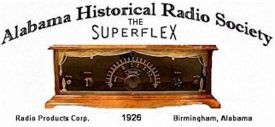Radio Products Corporation: Difference between revisions
(per Christopher Story) |
mNo edit summary |
||
| Line 4: | Line 4: | ||
House's primary innovation was an electric circuit that provided feedback to the tuner, allowing for "self-tuning". Superflex radios were also distinguished by using fewer vacuum tubes than 3-dial models and for having a distinctive "stage curtain" design on the front panel. | House's primary innovation was an electric circuit that provided feedback to the tuner, allowing for "self-tuning". Superflex radios were also distinguished by using fewer vacuum tubes than 3-dial models and for having a distinctive "stage curtain" design on the front panel. | ||
The company was not able to survive the [[Great Depression]]. Its assets were sold out of bankruptcy to repay investors. Some company records and the only known Superflex radio | The company was not able to survive the [[Great Depression]]. Its assets were sold out of bankruptcy to repay investors. Some company records and the only two known Superflex radio sets are owned by the [[Alabama Historical Radio Society]] and displayed in the lobby of the [[Alabama Power Building]] at 600 [[18th Street North]] in downtown Birmingham. | ||
<!--"He had more curiosity than fourteen cats!” That’s the way Ernest W. House, inventor and maker of the Superflex radio, is described. He was a true entrepreneur and inventor. An energetic man, House was noted for his mechanical and electronic genius. A person of immense talent, he was known to do everything from raising chickens to building a motorcycle in his mother's kitchen. He invented, then manufactured the Superflex radio in a factory in north Birmingham, the only known production faculty of its type in the deep south. | <!--"He had more curiosity than fourteen cats!” That’s the way Ernest W. House, inventor and maker of the Superflex radio, is described. He was a true entrepreneur and inventor. An energetic man, House was noted for his mechanical and electronic genius. A person of immense talent, he was known to do everything from raising chickens to building a motorcycle in his mother's kitchen. He invented, then manufactured the Superflex radio in a factory in north Birmingham, the only known production faculty of its type in the deep south. | ||
House came to Birmingham from Nashville at the young age of ten. Prior to going into the radio business he operated a typewriter firm, Typewriter Exchange, in downtown Birmingham. | House came to Birmingham from Nashville at the young age of ten. Prior to going into the radio business he operated a typewriter firm, Typewriter Exchange, in downtown Birmingham. | ||
Latest revision as of 15:33, 20 July 2013
The Radio Products Corporation was the Birmingham-based manufacturer of Superflex broadcast radio receivers. The corporation was founded in 1925 by inventor Ernest W. House with W. T. Estes and Jelk Cabiness. The company manufactured its radio sets in a facility at 3816 28th Street North in North Birmingham. The factory featured roof-mounted loudspeakers which were used for advertising and special public-interest broadcasts (such as radio coverage of prize fights).
House's primary innovation was an electric circuit that provided feedback to the tuner, allowing for "self-tuning". Superflex radios were also distinguished by using fewer vacuum tubes than 3-dial models and for having a distinctive "stage curtain" design on the front panel.
The company was not able to survive the Great Depression. Its assets were sold out of bankruptcy to repay investors. Some company records and the only two known Superflex radio sets are owned by the Alabama Historical Radio Society and displayed in the lobby of the Alabama Power Building at 600 18th Street North in downtown Birmingham.
References
- "Four-Tube One-Dial Control Receiver" (March 1927) Radio Retailing.
- Bates, George (January 1991) "SuperflexA-1021X:Manufacturing Radios In Birmingham". Radio Age. Vol. 16, No. 1
